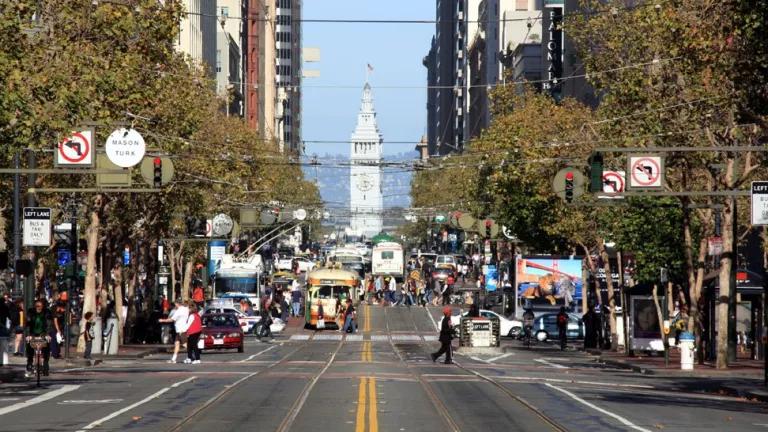
I am excited to announce that NRDC Urban Solutions will be partnering with Professor Susan Shaheen and her colleagues at UC Berkeley's Transportation Sustainability Research Center (TSRC) on the first-ever climate impacts analysis of the ridesourcing/transportation network companies (TNCs), Uber and Lyft. Generous support from the Hewlett Foundation and the San Francisco County Transportation Authority is enabling this work[1].
This is an important and exciting development in the shared mobility landscape.
The pressure and urgency to fight climate change has never been greater, with national, state, and local agendas focused on reducing emissions and finding innovative solutions. In California, where I work, transportation makes up 40 percent of all emissions, and we have on record some of the most ambitious climate goals in the world. It's clear that to meet these targets, we must reduce the rate of growth of vehicle miles traveled (VMT).
In my hometown of San Francisco, it is undeniable that technology is fundamentally changing the way we get around. Numerous platforms are emerging at the intersection of the sharing economy and the transportation sector, in what we call shared mobility. To say that shared mobility is a buzz word is an understatement. The effects of these new modes -- bikesharing, carsharing, ridesharing--or any method of sharing resources to enhance mobility -- is at the forefront of the conversation around the future of transportation.
Some of the most frequently used and fastest growing among these are app-based services like Uber and Lyft. Both companies started by offering on-demand "ridesourcing" or TNC options, and they have evolved to allow passengers traveling along the same route to share rides through what we now call "ridesplitting" via services such as UberPool and Lyft Line.
The pace of growth of these companies, which didn't exist just a few years ago, is exponential. They operate in hundreds of cities and dozens of countries, with supporting legislation in more than half of the United States. In San Francisco, 25% of residents say they have used Uber or Lyft at least once in the last month.
A key unanswered question for those of us who think daily about strategies to reduce emissions is: What is the climate impact of these new options?
Some hypothesize that on-demand rides encourage people to leave their own cars at home or even get rid of them altogether. Some highlight that for the first time, these companies are enabling real-time, dynamic ride-matching, which has been something of a holy grail in transportation planning for decades. Still, others wonder if these companies are competing with public transit, substituting for walking and biking trips, or perhaps adding more cars to the road.
The truth is, no one knows the answers to these questions...yet.
In our effort to advance this conversation around the climate, equity, and policy implications of shared mobility, NRDC Urban Solutions led the Live.Ride.Share conference in Los Angeles in February. Since then we have continued to work with partners to explore and analyze this new landscape, providing insight to policymakers and launching a low-income, all electric carsharing pilot in Los Angeles. We could not be more excited to continue this work and to be leading the effort with this next piece of the puzzle - exploring the true impact on climate of ridesourcing/TNCs.
As you can imagine, a first-of-its-kind undertaking like this is no small feat. We hope to publish our industry-level findings early next fall. The goal is to contribute to a better understanding of the impact of these major new players in the transportation ecosystem so that we can design a regulatory framework that can help to achieve our social and environmental goals.
[1] Lyft and Uber are not contributing financially to this study.



